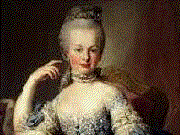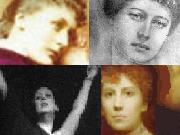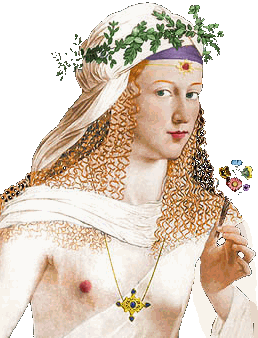Womania
| Lucrezia Borgia |
| Table of Contents |
|
Books on eBay ???
Why not!
Click the picture below!
Enter the BOOKS category and
Find fun and bargains!


Lucrezia’s Second Marriage
Meanwhile, catching a glimpse of new benefits, the Pope formed an alliance with the king of Naples, and Lucrezia got married to Alfonso of Aragon, Duke of Bisceglie—the seventeen-year-old son of the Neapolitan king.
A certain chronicler wrote that between the cancellation of the first wedding and the second, Lucrezia had been in love with a Spanish knight, Pedro Galdes, whom Cesare killed because the knight might interfere the marriage plan of the Borgias.
Lucrezia’s marriage to Duke of Bisceglie went smoothly. In due course, Lucrezia gave birth to a son, Rodrigo, whom both parents loved tenderly. Their marriage life seemed to go happy ever after.

In her arms, Lucrezia carried her son
to have him baptized.
However, Alfonso began to fear for his own life because the Pope formed an alliance with the French king who carried a strong ambition to take over the Neapolitan reign.
Alfonso escaped from Rome, but he returned to see his beloved son once again. In the evening of July 15, 1500, Alfonso walked near the Basilica of S. Peter on his way back to his lodging, when a group of ruffians attacked the duke, who received a number of near-fatal wounds. His servants carried back the seriously wounded master to the apartments of his wife, where Lucrezia and his own sister—Sancia, who had been married to Lucrezia’s youngest brother—put him to bed and, for a month, they had taken a turn to his bedside, making sure that he remained in good hands.
Unlike the popular belief that Lucrezia was a treacherous, cold-blooded woman, she actually loved Alfonso and, for the first time, she protected her own husband from the evil hand of her brother. Although both women didn’t exchange words, they knew exactly who was the culprit behind this failed assassination. Therefore, both women feared of another attack and prepared the food for the duke by themselves so that nobody could kill him with poison.
Cesare had already decided that Lucrezia’s second husband, Duke of Bisceglie, had lost his value to the Borgias since France and Spain had united to topple Bisceglie’s family in Naples. When the Pope called the women, who briefly walked out of the the chamber, Cesare’s right-hand man—Micheletto, alias Michele Corella—strangled the duke as he was recovering from wounds from an earlier attempt on his life by the henchmen.
In all likelihood, Alexander did not plan the murder, nor did he prevent such a plan from being hatched. Soon his son’s initiative allowed him to arrange a third marriage for Lucrezia.
Lucrezia’s Third Marriage
Cesar, with the help of his father, had conquered the wide part of the Romagna. But Cesare was not satisfied only with a return to Rome in triumph. Jubilee gifts went into his coffers, and Alexander shared with him the huge sums obtained from the creation of nine new cardinals, each paying thousands of ducats. Still, the Borgias were not satisfied.
With Duke of Bisceglie gone forever, Alexander arranged for Lucrezia a new wedding with Alfonso—the twenty-four-year-old, childless widower and legitimate heir to the duchy of Ferrara (incidentally, younger brother of Isabella d’Este).
Cesare wanted to revive the once-powerful papal state and to place himself as its duke. To realize this ambition, he wanted to establish a strong tie with Ferrara—a city-state adjacent to Cesare’s province of Romagna. A proxy marriage took place on December 30, 1501.
Alfonso—who had lost his first wife, Anna—had no intention to marry the widow (no matter how young and beautiful she was) because of her terrible reputation, but he had yielded to the pressures of his father, Ercole d’Este, Duke of Ferrara, who knew well enough that his duchy technically belonged to the papacy. So, if he refused the marriage, the Pope might take over his duchy as a means of last resort. To avoid this hopeless event, Duke of Ferrara had to give in.
On January 6, 1502, Lucrezia left her apartments in Rome, where she had lived for twenty years, and set off to Ferrara, where her husband had been waiting for her. Though reluctant at first, Alfonso seemed to like her when he met this delicate blond woman with sorrowful blue eyes, despite the awful rumors shrouding her.
In Ferrara, Lucrezia led an exemplary life to the standard of the virtue and the charity. Soon around the bride gathered

|
| Alfonso d’Este, Duke of Ferrara |
However, her happiness became clouded when her father and Cesare became ill in 1503. The people murmured that their enemies poisoned both men, though most historians believe that malaria was the culprit. In any case, Cesar survived but not the Pope.
Lucrezia sank to the depth of grief. Wearing in black, she remained in her room for days, seldom eating and sleeping. Pietro Bembo tried to cheer her up and entered the room. However, seeing her in distress beyond his reach, he gave up and returned in vain.
|
Cesare after his father’s death
and his marriage
After Alexander’s death in 1503, Cesare fled to Spain, and a little more than
three years after his father’s death, died there fighting bravely as a
mercenary.
After a few months into his marriage to Charlotte in 1498, Cesare never saw his wife again, nor their daughter, Louise. Charlotte, however, remained loyal to her husband’s memory. She and her daughter entered a convent, and lived pious lives until the death of Charlotte. Louise eventually married and had six children, giving rise to a line of competent soldiers. Cesare’s two illegitimate children, Camilla and Girolamo, suffered different fates. The daughter, Camilla, became an abbess, widely respected for her piety. The son, Girolamo, became a violent character, responsible for at least one murder and probably several others. He died, leaving two daughters, whose fates are unknown. Cesare’s propensity for murder apparently ends with his illegitimate son. Cesare’s life story might make you grimace, but he had greatly impressed at least one person—Niccolò di Bernardo Machiavelli (1469-1527). Indeed, he served as the model for Machiavelli’s The Prince, the leader who promotes himself through the strength of his own will and political expediency, instead of morality. |
In 1507 a new scandal took place. Ercole Strozzi, the well-known literary figure, was assassinated because of his passionate friendship with Lucrezia. Whether Lucrezia had him killed or whether Cesare succumbed to another fit of jealous rage has never been proven. Some historians believe that he had fallen a victim to Alphonso’s jealousy.
When Cesare died in the same year, she was devastated. However, she didn’t cry any more. She had learned how to endure the unbearable by now.
Instead, she set about establishing protection for Rodrigo, her son by her second husband, and “her brother”—the mysterious Giovanni—infans Romanus.
Against her husband’s wishes, she brought them to Ferrara, where they joined the teeming household. Eventually, the two young boys were sent to Isabella of Aragon, who promised to see to their education.
Rodrigo died in 1512, at the age of thirteen, and Lucrezia retired in grief to a convent. After a time, however, she returned to her husband.
After giving birth to her fifth child, while in Ferrara, who died shortly after being born, Lucrezia contracted puerperal fever, and died on June 24, 1519. She was thirty-nine years old.
One of her sons, Ercole, succeeded his father as Duke, and another, Ippolito, became a cardinal. Both were known for their love of luxury, and, as such, carried on the Borgia tradition of material excess.
- Tony Buggatti
Sensational and colorful stories always prevail in our history, pushing aside more decent and ordinary—therefore, monotonous—tales. Most of her episodes were thus exaggerated and spiced because of the demagoguery and propaganda of her enemies. If you take a close look at her attitudes and behaviors, you will know that her personality appears more like that of an ordinary woman. Lucrezia was definitely different from her strong-willed contemporaries such as Caterina Sforza and Isabella d’Este, who certainly possessed a strong mind. On the contrary, Lucrezia had a rather weak mind, which was always manipulated by her brother and father. Only after the death of both men could she find her own way of life.
- Akira
| Copyright Akira Kato About this author:
|

|
|
|||||||



























